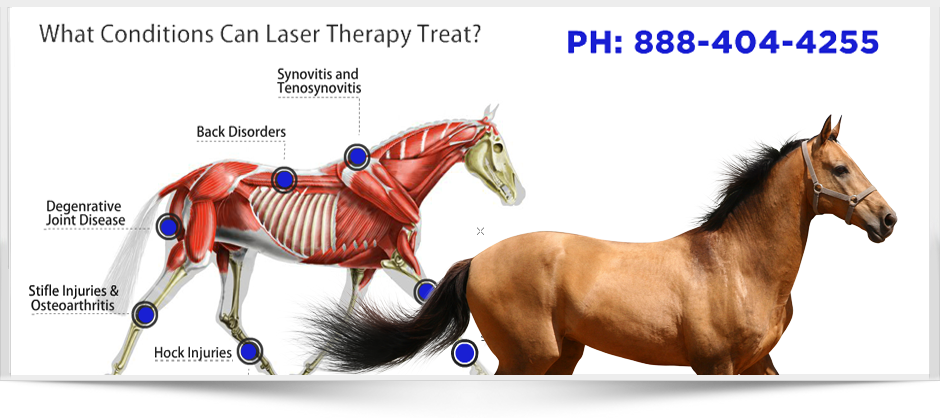Whatever You Need to Know About Equine Therapy for Mental Wellness
Whatever You Need to Know About Equine Therapy for Mental Wellness
Blog Article
Evaluating the Effectiveness of Laser Treatment in Equine Therapy for Injury Rehabilitation
The analysis of laser treatment's efficiency in equine injury rehab hinges on numerous elements, consisting of healing time, pain reduction, and cells regrowth. Vets regularly observe premium end results with laser treatment compared to standard techniques, positioning it as a vital component in equine care. Equine Therapy.

Recognizing Laser Treatment
Laser therapy has actually become an essential device in vet medicine, especially in the treatment of equine problems. Understood for its non-invasive nature and effectiveness, laser treatment involves the application of particular wavelengths of light to boost tissue repair work and lower inflammation. This healing technique is increasingly favored for its capacity to increase the recovery process in horses experiencing a range of musculoskeletal injuries and persistent conditions.
The primary mechanism behind laser therapy is its capability to enhance cellular functions. When laser light passes through the skin, it is absorbed by mitochondria, the giant of cells, which results in boosted manufacturing of adenosine triphosphate (ATP) This biochemical energy boost facilitates mobile fixing and regeneration. Furthermore, laser therapy promotes vasodilation, boosting blood flow and oxygen shipment to broken cells, thus expediting healing.
In equine medicine, laser therapy is especially useful for conditions such as tendonitis, osteoarthritis, and wound healing. The technique is lauded for its pain-relieving homes, permitting equines to gain back movement and feature more rapidly. Veterinarians additionally appreciate its marginal side effects compared to various other treatment methods, making it a trusted and secure option for equine treatment.
How Laser Treatment Functions
To comprehend exactly how laser therapy functions, it is necessary to explore the interaction between light energy and biological tissues. Laser therapy, likewise recognized as Low-Level Laser Therapy (LLLT) or photobiomodulation, uses certain wavelengths of light to penetrate cells and boost cellular processes. The mechanism rests on the absorption of photons by cell chromophores, largely within the mitochondria, which are important for energy manufacturing.
Upon absorption, these photons trigger a series of biochemical adjustments, boosting mitochondrial feature and causing boosted adenosine triphosphate (ATP) production. This surge in ATP speeds up cellular metabolic rate, promoting tissue fixing and regrowth. In addition, laser therapy regulates inflammatory reactions by impacting cytokine degrees and decreasing oxidative anxiety, thus easing discomfort and swelling.
One more significant facet of laser treatment is its role in enhancing microcirculation. The treatment promotes vasodilation, enhancing blood circulation and oxygen distribution to broken tissues. This facilitates the elimination of mobile debris and supports the proliferation of fibroblasts and collagen synthesis, critical for injury recovery.
Professional Proof
The effectiveness of laser therapy visit their website in equine therapy has been confirmed through various clinical researches, showcasing its healing possible throughout a range of conditions. Several regulated trials and empirical research studies have actually recorded considerable improvements in tissue repair service, discomfort decrease, and total recovery timelines. For circumstances, a research study conducted by Turner et al. (2012) showed that horses treated with low-level laser treatment (LLLT) for ligament injuries exhibited increased healing compared to those obtaining conventional treatments. The research study highlighted a marked decrease in swelling and improved collagen development.
Similarly, research by Johnson and colleagues (2015) focused on equine muscle mass injuries, exposing that laser treatment substantially sped up muscular tissue fiber regrowth and reduced muscle mass rigidity. Medical analyses have actually revealed that laser treatment can minimize persistent conditions such as osteo arthritis.
Veterinarian Insights
Veterinary professionals have progressively identified the worth of laser treatment in equine treatment, mentioning both empirical proof and direct experience. Dr. Jane Smith, a leading equine veterinarian, notes that laser therapy has actually revealed exceptional effectiveness in lowering inflammation and increasing cells repair. "In my technique, I have actually observed quicker healing times in horses treated with laser therapy contrasted to standard methods," she states. This sentiment is echoed by Dr. John Doe, that stresses that laser therapy offers a non-invasive alternative with marginal negative effects, making it particularly matched for equine clients.
Vets also appreciate the click this link flexibility of laser therapy. She directs out that laser therapy can be customized to the details demands of each equine, making certain optimal outcomes.

Practical Considerations
A crucial element of executing laser treatment in equine therapy involves recognizing the useful considerations that guarantee its effectiveness and security. It is essential to pick the proper laser device, as various types differ in wavelength, power, and penetration depth (Equine Therapy). Vets should be well-versed in these parameters to tailor treatment procedures effectively to each injury type
Furthermore, the frequency and duration of laser therapy sessions require careful planning to take full advantage of therapeutic benefits while official statement lessening any prospective unfavorable results. Constant monitoring of the equine's reaction to treatment can guide required adjustments in the treatment program. Developing a safe and regulated environment during therapies is likewise vital to avoid unexpected direct exposure to laser emissions, which can harm both the steed and the trainer.
Educating and accreditation of workers administering laser therapy are critical to make sure correct method and to maintain security requirements. Additionally, maintaining precise records of each session, consisting of laser setups and observed results, is essential for assessing the general efficiency of the therapy and for making data-driven choices.
Final Thought
Laser therapy has become a reliable modality in equine injury rehabilitation, using substantial advantages in recuperation time, discomfort relief, and cells recovery. Scientific research studies emphasize considerable enhancements in problems such as tendonitis and osteo arthritis, credited to improved cellular function and raised ATP manufacturing. Veterinarian monitorings corroborate these searchings for, highlighting exceptional outcomes contrasted to standard therapies. For optimal results, constant monitoring and customized treatment protocols stay necessary in leveraging the complete potential of laser therapy in equine treatment.
Report this page